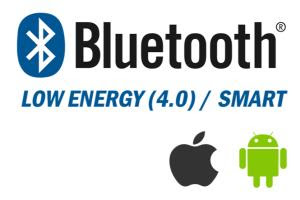Bluetooth low energy
What's Bluetooth low energy?
A new radio, new protocol stack, new profile architecture and a new qualification regime.
It’s designed to run from coin cells and support an Apps Store model. It is a radio standard for a new decade, enabling the Internet of Things (IoT)
Features:
- Mostly new PHY; some parts derived from the Basic Rate (BR) radio
- New advertising mechanism, for ease of discovery & connection
- Asynchronous connection-less MAC: used for low latency, fast transactions (e.g. 3ms from start to finish)
- New Generic Attribute Profile to simplify devices and the software that uses them.
- Asynchronous Client / Server architecture
Designed to be LOWEST cost and EASY to implement
Bluetooth Low Energy (BLE), sometimes referred to as "Bluetooth Smart", is a light-weight subset of classic Bluetooth and was introduced as part of the Bluetooth 4.0 core specification. While there is some overlap with classic Bluetooth, BLE actually has a completely different lineage and was started by Nokia as an in-house project called 'Wibree' before being adopted by the Bluetooth SIG.
There are plenty of wireless protocols out there for engineers and product designers, but what makes BLE so interesting is that it's almost certainly the easiest way to design something that can talk to any modern mobile platform out there (iOS, Android, Windows phones, etc.), and particularly in the case of Apple devices it's the only HW design option that doesn't require you to jump through endless hoops to be able to legally market your product for iOS devices.
Support for Bluetooth 4.0 and Bluetooth Low Energy (which is a subset of BT 4.0) is available on most major platforms as of the versions listed below:
- iOS5+ (iOS7+ preferred)
- Android 4.3+ (numerous bug fixes in 4.4+)
- Apple OS X 10.6+
- Windows 8 (XP, Vista and 7 only support Bluetooth 2.1)
- GNU/Linux Vanilla BlueZ 4.93+
Bluetooth low energy factsheet
Range: ~ 150 meters open field
Output Power: ~ 10mW (10dBm)
Max Current: ~ 15mA
Latency: 3 ms
Topology: Star
Connections: > 2 billion
Modulation: GFSK @ 2.4 GHz
Robustness: Adaptive Frequency Hopping, 24 bit CRC
Security: 128bit AES CCM
Sleep current ~ 1µA
Modes: Broadcast, Connection, Event Data Models Reads, Writes
Specification :Implementation specific
How low can the energy get?
From the previous slide, calculate energy per transaction
- Assume an upper bound of 3ms per minimal transaction
- Est TX power is 15mW (mostly TX power amp for 65nm chips).
- For 1.5v battery, this is 10ma. 0.015 W x .003 sec = 45 micro Joule
How long could a sensor last on a battery?
- An example battery: Lenmar WC357, 1.55v, 180mAh, $2-5.
- 180mAh/10ma = 18Hr = 64,800 seconds = 21.6M transactions
- Suppose this sensor sends a report every minute = 1440/day
- For just the BT LE transactions, this is 15,000 days, or >40 yr
- This far exceeds the life of the battery and/or the product
This means that battery will cost more than the electronics.
- This sensor could run on scavenged power, e.g. ambient light.
What is Bluetooth Low Energy Good for?
Connecting the things we carry with us:
- Watches: remote display from other devices
- Tags: locate objects or keep track of them (e.g. warning if you walk away)
- Health/fitness sensors (e.g. pedometer in your shoes)
- Body sensors (e.g. blood pressure, pulse rate, etc)
Accessing the things around us:
- Fobs: use proximity as a security/access control means
- Home and office automation
Low duty cycle M2M communication:
- Sensors and controls in homes, offices and factories
Communication within a system
- Car to car wheels/tires
Connecting anything that has intrinsic data to the Internet
Opportunities
New classes of gadgets
- Around a person
- Around a house
- In your car
New applications on PCs and smart phones
- Use those devices
New web services
- Anything can connect to the Web
New Social Applications
- Your beer glass can talk to your Facebook page :p
What are the USE CASES planned for BT 4.0?
Proximity
Time
Emergency
Network availability
Personal User Interface
Simple remote control
Browse over Bluetooth
Temperature Sensor
Humidity Sensor
HVAC
Generic I/O (automation)
Battery status
Heart rate monitor
Physical activity monitor
Blood glucose monitor
Cycling sensors
Pulse Oximeter
Body thermometer
And that’s just the starting point…
Example use: proximity
It can enable proximity detection
I’m in the car
I’m in the office
I’m in the meeting room
I’m in the movie theater
It can enable presence detection
Turn the lights on when I walk around the house
Automatically locks the door when I leave home
Turns the alarm off if I’m already awake




Comments
Post a Comment